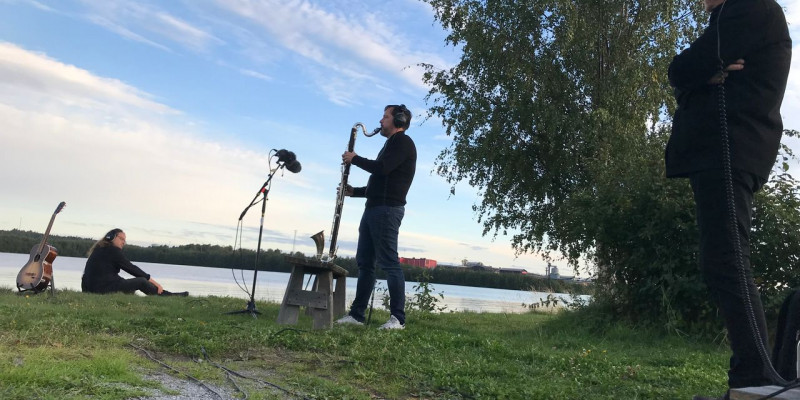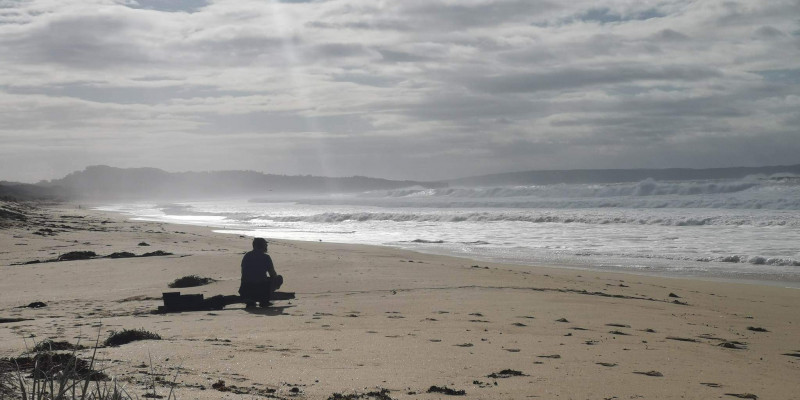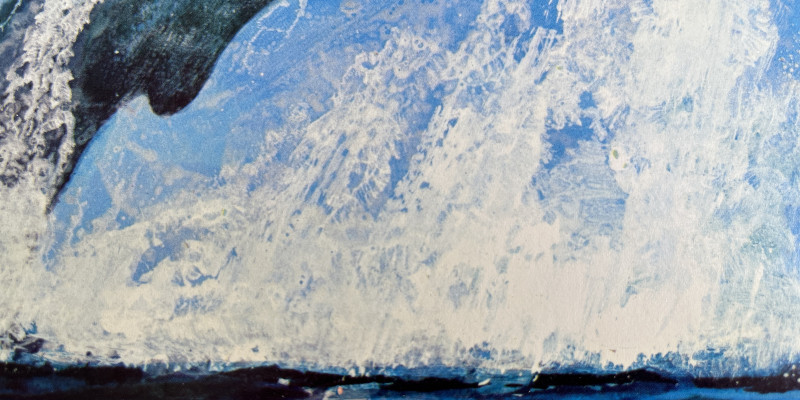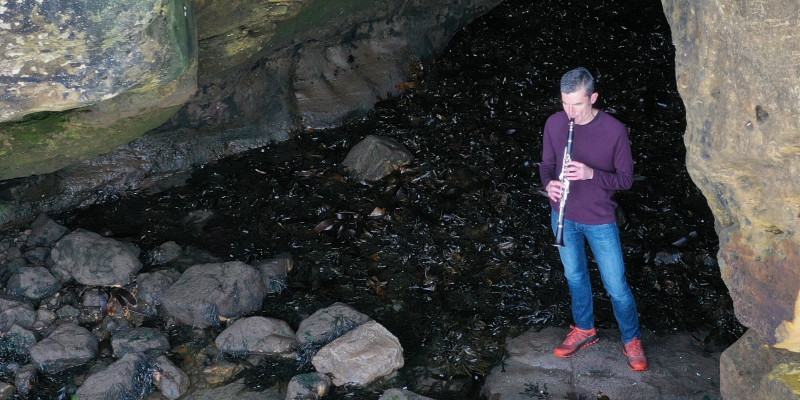Sounding migrations
Abstract
The migrations of baleen whales generally go little noticed, yet they have a profound effect on underwater sonic milieux. Seasonal fluctuations in the songs of the humpback, minke, and sei whales are underpinned by the near-constant subsonic bass pulse of the fin whale. As underwater acoustic monitoring is helping to reveal, migration routes and timings of these top predators are shifting in response to changing ocean temperatures. Such monitoring allows whales to be used as climate sentinels, facilitates conservation efforts, and also offers the prospect of building on public »whale listening« projects such as OrcaSound. Widening public access to underwater acoustic data would permit an active deep listening with the potential of generating a fuller engagement with marine environments, complementing the everyday awareness of birdsong that connects even urban citizens of industrial societies to the more-than-human world. Using underwater recordings from the North Atlantic supplied by the Marine Directorate of the Scottish Government I simulate the yearly pattern of cetacean song, aiming to show the listener that different species are readily distinguished and »good to listen with«: they attract and hold the attention, extending our sense of dwelling in a world always already experienced by other sentient beings.
Listening
Headphone listening is advised for full appreciation of the sonic range of the whale vocalizations.
Acknowledgements
I would like to thank Prof Şebnem Susam-Saraeva (University of Edinburgh) and two anonymous referees for helpful feedback on an earlier version of this audio paper, and Dr Nienke van Geel (Scottish Association for Marine Science) for facilitating access to the field recordings.
Listening on your mobile device? Here's a direct link to Soundcloud
Bibliography
Bakker, K. (2024). The Sounds of Life: How Digital Technology Is Bringing Us Closer to the Worlds of Animals and Plants. Princeton; Oxford: Princeton University Press.
Baumgartner, M.F., Bonnell, J., Van Parijs, S.M., Corkeron, P.J., Hotchkin, C., Ball, K., Pelletier, L.-P., Partan, J., Peters, D., Kemp, J., Pietro, J., Newhall, K., Stokes, A., Cole, T.V.N., Quintana, E. and Kraus, S.D. (2019). »Persistent near real-time passive acoustic monitoring for baleen whales from a moored buoy: System description and evaluation«. Methods in Ecology and Evolution, 10(9), pp. 1476–1489. Available at: https://doi.org/10.1111/2041-210X.13244.
Bengtsson, O., Lydersen, C. and Kovacs, K.M. (2022). »Cetacean spatial trends from 2005 to 2019 in Svalbard, Norway«. Polar Research, 41. Available at: https://doi.org/10.33265/polar.v41.7773.
Berrow, S.D., Massett, N., Whooley, P., Jann, B.V.M., Lopez-Suárez, P., Stevick, P.T. and Wenzel, F.W. (2021). »Resightings of humpback whales (Megaptera novaeangliae) from Ireland to a known breeding ground: Cabo Verde, West Africa«. Aquatic Mammals, 47(1), pp. 63–70. Available at: https://doi.org/10.1578/AM.47.1.2021.63.
Chicco, C., Papale, E., Wensveen, P.J., Mouy, X. and Samarra, F.I.P. (2025). »Using acoustic monitoring to reveal nearly year-round presence of humpback whales (Megaptera novaeangliae) in the waters of southern Iceland«. Marine Mammal Science, 41(2), p. e13198. Available at: https://doi.org/10.1111/mms.13198.
Clark, C.W. and Garland, E.C. (eds) (2022). Ethology and Behavioral Ecology of Mysticetes. Cham: Springer International Publishing (Ethology and Behavioral Ecology of Marine Mammals). Available at: https://doi.org/10.1007/978-3-030-98449-6_11.
van Geel, N.C.F., Risch, D., Benjamins, S., Brook, T., Culloch, R.M., Edwards, E.W.J., Stevens, C. and Wilson, B. (2022). »Monitoring cetacean occurrence and variability in ambient sound in Scottish offshore waters«. Frontiers in Remote Sensing, 3. Available at: https://doi.org/10.3389/frsen.2022.934681.
Geijer, C.K.A., Notarbartolo di Sciara, G. and Panigada, S. (2016). »Mysticete migration revisited: Are Mediterranean fin whales an anomaly?«. Mammal Review, 46(4), pp. 284–296. Available at: https://doi.org/10.1111/mam.12069.
Gumbs, A.P. (2020). Undrowned: Black Feminist Lessons from Marine Mammals. Chico, CA; Edinburgh: AK Press.
Gutiérrez-Muñoz, P., Walters, A.E.M., Dolman, S.J. and Pierce, G.J. (2021). »Patterns and trends in cetacean occurrence revealed by Shorewatch, a land-based citizen science program in Scotland (United Kingdom)«. Frontiers in Marine Science, 8, p. 642386. Available at: https://doi.org/10.3389/fmars.2021.642386.
Hazen, E.L., Abrahms, B., Brodie, S., Carroll, G., Jacox, M.G., Savoca, M.S., Scales, K.L., Sydeman, W.J. and Bograd, S.J. (2019). »Marine top predators as climate and ecosystem sentinels«, Frontiers in Ecology and the Environment, 17(10), pp. 565–574. Available at: https://doi.org/10.1002/fee.2125.
Helmreich, S. (2012). »Underwater Music: Tuning Composition to the Sounds of Science«. In T. Pinch and K. Bijsterveld (eds) The Oxford Handbook of Sound Studies, pp. 151-175.
Johnson, H.D., Taggart, C.T., Newhall, A.E., Lin, Y.-T. and Baumgartner, M.F. (2022). »Acoustic detection range of right whale upcalls identified in near-real time from a moored buoy and a Slocum glider«. The Journal of the Acoustical Society of America, 151(4), pp. 2558-2575. Available at: https://doi.org/10.1121/10.0010124.
Kettemer, L.E., Rikardsen, A.H., Biuw, M., Broms, F., Mul, E. and Blanchet, M.-A. (2022). »Round-trip migration and energy budget of a breeding female humpback whale in the Northeast Atlantic«. PLOS ONE, 17(5), p. e0268355. Available at: https://doi.org/10.1371/journal.pone.0268355.
Lindenmayer, D. and Scheele, B. (2017). »Do not publish«. Science, 356(6340), pp. 800–801. Available at: https://doi.org/10.1126/science.aan1362.
Nieukirk, S.L., Mellinger, D.K., Dziak, R.P., Matsumoto, H. and Klinck, H. (2020). »Multi-year occurrence of sei whale calls in North Atlantic polar waters«. The Journal of the Acoustical Society of America, 147(3), pp. 1842–1850. Available at: https://doi.org/10.1121/10.0000931.
Oliveros, P. (2010). Sounding the Margins: Collected writings, 1992-2009. Edited by L. Hall. Kingston NY: Deep Listening Publications.
Papale, E., Pelagatti, M., Pedrazzi, G. and Buscaino, G. (2023). »Occurrence and patterns of fin whale songs reveal alternative migration strategies in Svalbard Islands, Norway«. Scientific Reports, 13(1), p. 4436. Available at: https://doi.org/10.1038/s41598-023-31665-x.
Payne, R.S. (1970). Songs of the Humpback Whale [Vinyl]. Capital Records ST-620.
Payne, R.S. (1995). Among Whales. New York: Scribner.
Storrie, L., Lydersen, C., Andersen, M., Wynn, R.B. and Kovacs, K.M. (2018). »Determining the species assemblage and habitat use of cetaceans in the Svalbard Archipelago, based on observations from 2002 to 2014«. Polar Research, 37, p. 1463065.
Truax, B. (1996). »Soundscape, acoustic communication and environmental sound composition«. Contemporary Music Review, 15(1-2), pp. 49–65. Available at: https://doi.org/10.1080/07494469608629688.
van Weelden, C., Towers, J.R. and Bosker, T. (2021). »Impacts of climate change on cetacean distribution, habitat and migration«. Climate Change Ecology, 1, p. 100009. Available at: https://doi.org/10.1016/j.ecochg.2021.100009.
Whitehouse, A. (2017). »Loudly sing cuckoo: More-than-human seasonalities in Britain«. The Sociological Review, 65(1_suppl), pp. 171–187. Available at: https://doi.org/10.1177/0081176917693533.
Keywords
Sound and the More-Than-Human Worlds
Fokusartikler

Love unto death
The multispecies aesthetics of birdsong and bird extinction in Indonesia
- Nils Bubandt,
- Sanne Krogh Groth

Alarming calls and whispering winds
On game-calling instruments, mimicry and intersubjectivity
- Nele Möller

Sonic animism?
»Deep« listening into field recordings and scientific audio collections
- Kirsten Reese

Real-time norms
Grooves, drones, and sense-making in experimental improvised music
- Christopher A. Williams,
- Joshua Bergamin

What do puppets hear?
The uncanny other world of the imagined consciousness of puppets
- Matt Smith,
- Paul J. Rogers

Embracing unnaturalness
Computer voices & trans sound studies
- Paulus van Horne

Algorithmic mythologies
Failure as a cultural tool
- Debashis Sinha

Being-at-work in the field
Rethinking field recording through energy ethics and actualisation
- Julian Weaver

Whose voice is your voice?
Control, identity and metahuman sounds in AI audio compression codes
- Alberto Ricca

Ambient tremology
Vibratory linkages in the Danube Delta
- Kosmas Phan Ðinh,
- Mae Lubetkin,
- Michal Mitro

How ocean dreams
Sonic transmissions, deep-sea ecologies, and pluriversal listening
- Konstantinos Damianakis,
- Jol Thoms

Infrasound and the planetary imaginary
Making the changing atmosphere audible through infrasonic listening
- Brian House

Sounds by water and trees
Exploring place through mediated listening
- Anders Hultqvist,
- Stefan Östersjö,
- Jan Berg,
- Robert Ek

Listening in slug time
Listening slowly with bodies, critters, and the temporalities of the garden
- Cathy Lane,
- Maya Lane

Listening with earth
Deep listening, vibrational ecologies, and sonic stories of the more-than-human
- Diana Chester,
- Damien Ricketson

Listening for mermaids
The otherworldly life of Lewisham's Rivers
- Louise Rondel,
- Emma Jackson,
- Konstantinos Damianakis

Glacial withness
Listening at the edge of planetary boundaries
- Angela Snæfellsjökuls Rawlings,
- Santiago Rueda-García,
- Konstantine Vlasis,
- Daniela Amado,
- Adam Świtała,
- Rike Scheffler,
- Linnéa Ida-Maria Falck

Ocean sense
Listening, technology and the sonic researcher
- Mark Peter Wright,
- Denise Risch

Sounding migrations
Deep listening and the acoustic phenology of whale song
- Alex South